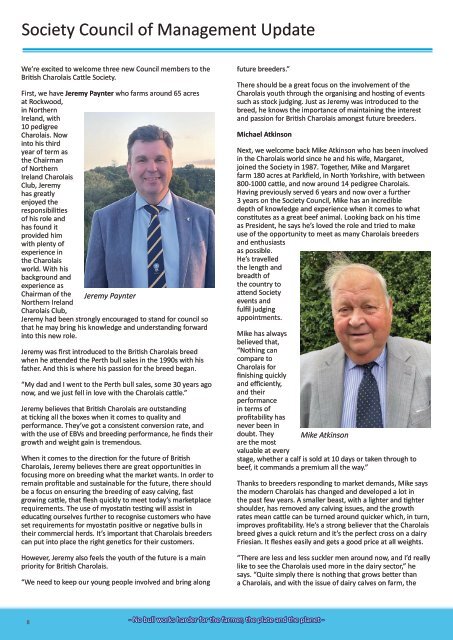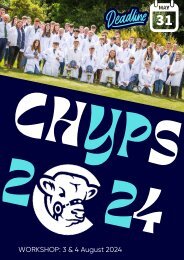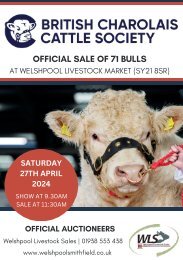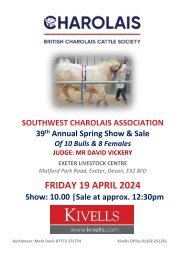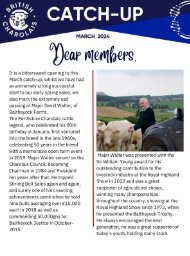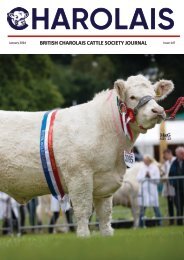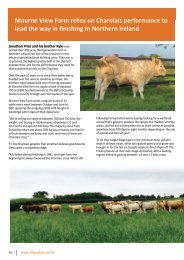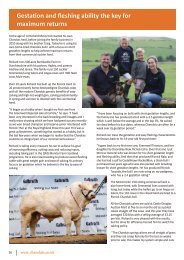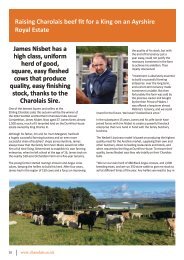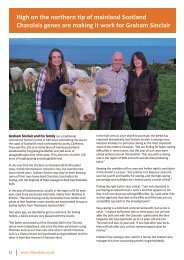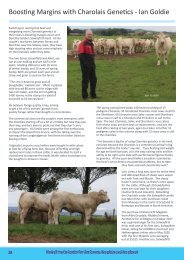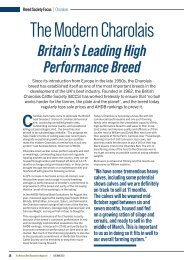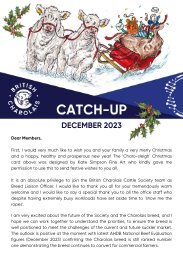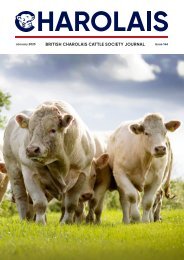BCCS September Newsletter 2022
BCCS September Newsletter 2022
BCCS September Newsletter 2022
- No tags were found...
You also want an ePaper? Increase the reach of your titles
YUMPU automatically turns print PDFs into web optimized ePapers that Google loves.
Society Council of Management Update<br />
We’re excited to welcome three new Council members to the<br />
British Charolais Cattle Society.<br />
First, we have Jeremy Paynter who farms around 65 acres<br />
at Rockwood,<br />
in Northern<br />
Ireland, with<br />
10 pedigree<br />
Charolais. Now<br />
into his third<br />
year of term as<br />
the Chairman<br />
of Northern<br />
Ireland Charolais<br />
Club, Jeremy<br />
has greatly<br />
enjoyed the<br />
responsibilities<br />
of his role and<br />
has found it<br />
provided him<br />
with plenty of<br />
experience in<br />
the Charolais<br />
world. With his<br />
background and<br />
experience as<br />
Chairman of the<br />
Northern Ireland<br />
Charolais Club,<br />
Jeremy Paynter<br />
Jeremy had been strongly encouraged to stand for council so<br />
that he may bring his knowledge and understanding forward<br />
into this new role.<br />
Jeremy was first introduced to the British Charolais breed<br />
when he attended the Perth bull sales in the 1990s with his<br />
father. And this is where his passion for the breed began.<br />
“My dad and I went to the Perth bull sales, some 30 years ago<br />
now, and we just fell in love with the Charolais cattle.”<br />
Jeremy believes that British Charolais are outstanding<br />
at ticking all the boxes when it comes to quality and<br />
performance. They’ve got a consistent conversion rate, and<br />
with the use of EBVs and breeding performance, he finds their<br />
growth and weight gain is tremendous.<br />
When it comes to the direction for the future of British<br />
Charolais, Jeremy believes there are great opportunities in<br />
focusing more on breeding what the market wants. In order to<br />
remain profitable and sustainable for the future, there should<br />
be a focus on ensuring the breeding of easy calving, fast<br />
growing cattle, that flesh quickly to meet today’s marketplace<br />
requirements. The use of myostatin testing will assist in<br />
educating ourselves further to recognise customers who have<br />
set requirements for myostatin positive or negative bulls in<br />
their commercial herds. It’s important that Charolais breeders<br />
can put into place the right genetics for their customers.<br />
However, Jeremy also feels the youth of the future is a main<br />
priority for British Charolais.<br />
“We need to keep our young people involved and bring along<br />
future breeders.”<br />
There should be a great focus on the involvement of the<br />
Charolais youth through the organising and hosting of events<br />
such as stock judging. Just as Jeremy was introduced to the<br />
breed, he knows the importance of maintaining the interest<br />
and passion for British Charolais amongst future breeders.<br />
Michael Atkinson<br />
Next, we welcome back Mike Atkinson who has been involved<br />
in the Charolais world since he and his wife, Margaret,<br />
joined the Society in 1987. Together, Mike and Margaret<br />
farm 180 acres at Parkfield, in North Yorkshire, with between<br />
800-1000 cattle, and now around 14 pedigree Charolais.<br />
Having previously served 6 years and now over a further<br />
3 years on the Society Council, Mike has an incredible<br />
depth of knowledge and experience when it comes to what<br />
constitutes as a great beef animal. Looking back on his time<br />
as President, he says he’s loved the role and tried to make<br />
use of the opportunity to meet as many Charolais breeders<br />
and enthusiasts<br />
as possible.<br />
He’s travelled<br />
the length and<br />
breadth of<br />
the country to<br />
attend Society<br />
events and<br />
fulfil judging<br />
appointments.<br />
Mike has always<br />
believed that,<br />
“Nothing can<br />
compare to<br />
Charolais for<br />
finishing quickly<br />
and efficiently,<br />
and their<br />
performance<br />
in terms of<br />
profitability has<br />
never been in<br />
doubt. They Mike Atkinson<br />
are the most<br />
valuable at every<br />
stage, whether a calf is sold at 10 days or taken through to<br />
beef, it commands a premium all the way.”<br />
Thanks to breeders responding to market demands, Mike says<br />
the modern Charolais has changed and developed a lot in<br />
the past few years. A smaller beast, with a lighter and tighter<br />
shoulder, has removed any calving issues, and the growth<br />
rates mean cattle can be turned around quicker which, in turn,<br />
improves profitability. He’s a strong believer that the Charolais<br />
breed gives a quick return and it’s the perfect cross on a dairy<br />
Friesian. It fleshes easily and gets a good price at all weights.<br />
“There are less and less suckler men around now, and I’d really<br />
like to see the Charolais used more in the dairy sector,” he<br />
says. “Quite simply there is nothing that grows better than<br />
a Charolais, and with the issue of dairy calves on farm, the<br />
8<br />
- No bull works harder for the farmer, the plate and the planet -<br />
<strong>September</strong> newsletter 22.indd 8 16/09/<strong>2022</strong> 14:57:29


